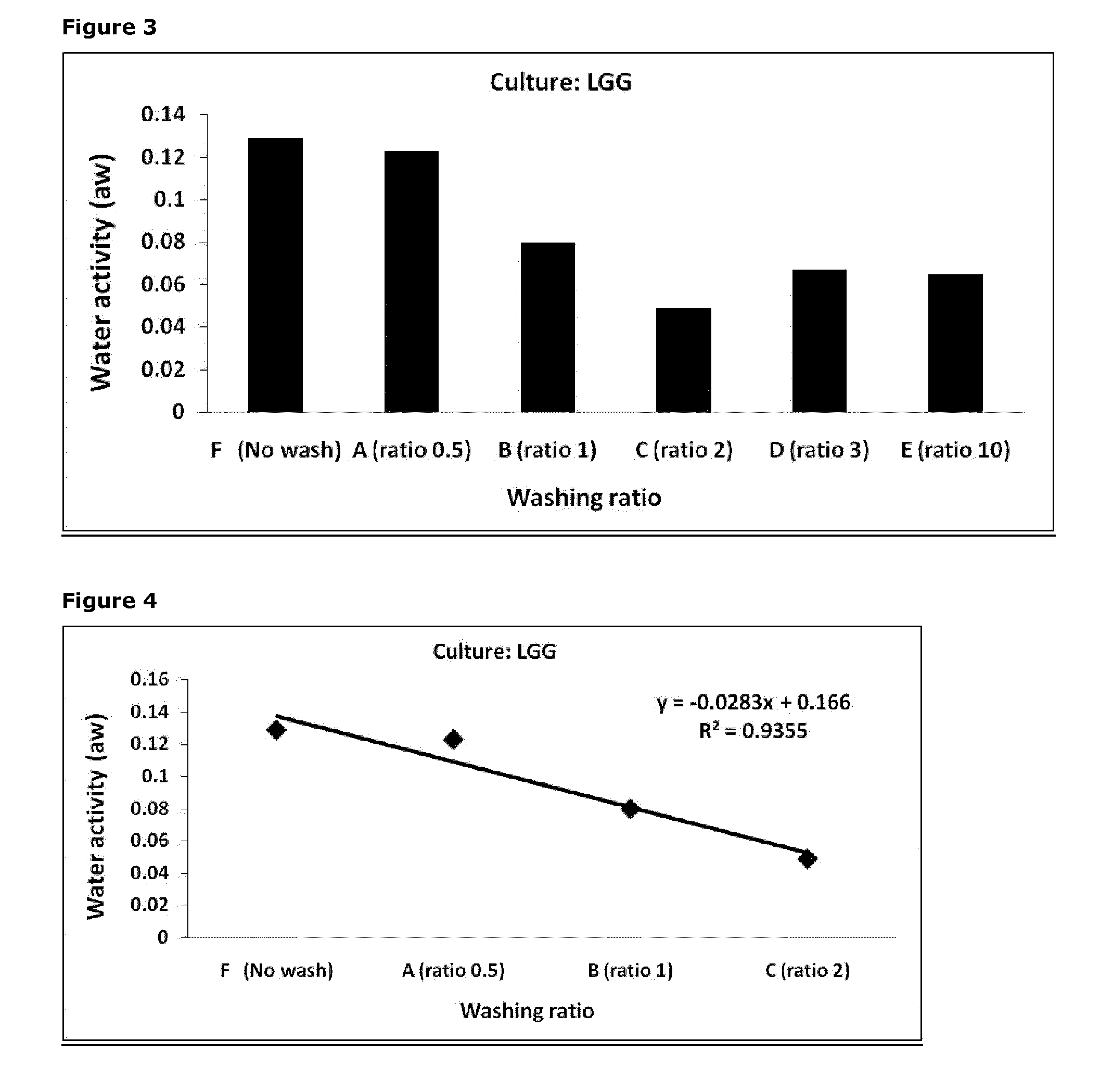Method for freeze drying a bacteria-containing concentrate
- Summary
- Abstract
- Description
- Claims
- Application Information
AI Technical Summary
Benefits of technology
Problems solved by technology
Method used
Image
Examples
example 1
Bifidobacterium animalis BB-12®: Comparison of Unwashed Vs. Washed Concentrates with Respect to the Effect of the Washing Ratio on Water Activity of Freeze-Dried Products. Water was Used as the Washing Solution
[0253]The Bifidobacterium animalis strain BB-12® was cultivated in MRS medium under standard conditions with controlled pH and temperature during the fermentation in a 700 L reactor, the culture was harvested at early stationary phase and concentrated approx. 14 fold by centrifugation.
[0254]After centrifugation, the bacterial concentrate was divided into 6 portions.
[0255]5 portions were mixed with water (deionised) in various ratios (ranging from 0.5 to 10) resulting in washed concentrates A-E as given below. The washing was done for 15 min at room temperature using a magnetic stirrer. After washing, the cells were harvested by lab-scale centrifugation (Sorvall RC 6 Plus, Thermo Scientific) for 20 minutes at 10000 g and 4° C. A part of the supernatant was removed after centrif...
example 2
Lactobacillus rhamnosus LGG®: Comparison of Unwashed vs. Washed Concentrates with Respect to the Effect of the Washing Ratio on the Water Activity of Freeze-Dried Products. Water was Used as the Washing Solution
[0268]The LGG® was cultivated in MRS medium under standard conditions with controlled pH and temperature during the fermentation in a 700 L reactor. The culture was harvested at early stationary phase and concentrated approx. 14 fold by centrifugation. After centrifugation, the bacterial concentrate was divided into 6 portions, washed with deionized water, and a cryo-protective solution was added as described in Example 1. Freeze-drying and water activity measurements were performed as described in Example 1.
[0269]Results
[0270]The experiment presented in this example is identical to that given in Example 1 except that it was carried out with another bacterial culture, i.e. the Lactobacillus rhamnosus LGG®. The results are presented in FIG. 3.
[0271]The results of this experime...
example 3
Lactobacillus acidophilus LA-5®: Comparison of Freeze-Dried Products of Washed and Unwashed Cell Concentrates with Respect to Five Different Washing Solutions
[0278]The culture LA-5® was cultivated in MRS medium under standard conditions with controlled pH and temperature during the fermentation, in a 700 L reactor. The culture was harvested at early stationary phase and concentrated approx. 14 fold by centrifugation.
[0279]After centrifugation, the bacterial concentrate was divided into 5 portions. 4 portions were mixed with a particular washing solution (see table below), i.e. one volume of concentrate was mixed with two volumes of washing solution as given below (A, B, C, D). 1 portion was used as control (unwashed concentrate E).
[0280]The washing process, addition of cryo-protective solution, freeze-drying, and water activity measurements were performed as described in Example 1. The following washing solutions were used:
Ratio of washing solution toPortionculture concentrateWashin...
PUM
 Login to View More
Login to View More Abstract
Description
Claims
Application Information
 Login to View More
Login to View More - R&D
- Intellectual Property
- Life Sciences
- Materials
- Tech Scout
- Unparalleled Data Quality
- Higher Quality Content
- 60% Fewer Hallucinations
Browse by: Latest US Patents, China's latest patents, Technical Efficacy Thesaurus, Application Domain, Technology Topic, Popular Technical Reports.
© 2025 PatSnap. All rights reserved.Legal|Privacy policy|Modern Slavery Act Transparency Statement|Sitemap|About US| Contact US: help@patsnap.com



